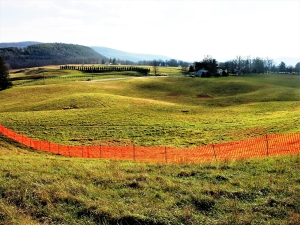A Line Drawn in the Sand
The Cooperstown Geologist
Updated by Robert and Johanna Titus
March 2007
A geologist is privileged to see the world differently from other people. That’s not arrogance; that’s just the product of a lot of experience in our science. We would like to prove this by taking you up a road you have probably traveled many times. On our trip I would like to show you what I see; it may change your perceptions.
Head south from Cooperstown on Rte. 28 until you reach County Rte. 26 and turn right (west). Drive to the top of the hill and park (safely; it is a busy highway). Across the road on the south side is a wonderful panoramic view of the upper Susquehanna. It is also a panoramic view of the Ice Age.

Right in front of you is a series of pretty little rolling hillocks. They rise and fall like waves upon a roiling ocean, but these “waves” are much more smoothed out than those of an ocean. Use the words sinuous or sinuosity to describe this land. Is this view just something pretty, or is there more?
There’s more. We geologists look at these forms and call them kames and kettles. The kames are the sinuous rises while the kettles are the sinuous depressions. How did they get there and what do they have to do with the Ice Age? Turn around and look.
North of the road today is a farmstead, but in our mind’s eye we look and we see a glacier. A big dirty, wet pile of glacial ice lies right where the farm should be. It is melting and melting rapidly. Boulders, cobbles and earth are tumbling out of the dirty ice. Thundering flows of turbid water are cascading off the glacier and streams of agitated meltwater are flowing to the south.
Turn around again and look south. The turning may make you dizzy but the travel through time makes it worse. We are now in the year 12,356 BC and before us is another, more barren vision of an ice age Cooperstown. In the distance, just east of and across today’s Rte. 28, lies a glistening plain of soggy wet sediment. It’s the freshly deposited sediment that was washed out by those meltwater streams. Those creeks have broken up into a braiding of crisscrossing rivulets and it is these that have been spreading the sediment across that flat plain.
But now gaze immediately to our front. We see those sinuous hillocks again, but now stripped of their modern grasses; it is a freshly formed kame and kettle landscape. The kames are wet heaps of sand and gravel. There are a lot of boulders in them and some of them are enormous. It’s the kettles that tell much of the story. At the bottom of each is a mass of dirty ice. Those are “the tips of ice bergs.” It seems that each kettle formed where a large broken chunk of glacier had gotten itself buried. The climate has been warming and those masses of buried ice have been slowly melting. As they have done so the land above them has collapsed into those pretty sinuosities we call kettles.
We slowly become aware of what has taken place here. From behind us a great glacier has advanced down the Susquehanna Valley. It reached today’s Rte. 26 and there it came to a halt. Briefly the forces that drive the glacier forward were exactly balanced by the processes of melting. Boulders, cobbles and sandy gravel were brought to the front of the ice and dumped just south of today’s Rte. 26. It’s something geologists call a glacial moraine. The melting glacier provided the streams of water that carried much of the sediment beyond the moraine and deposited it on that plain we see across Rte. 28. Geologists call this an outwash deposit; it is a good name.
The whole assemblage of landforms is called a “moraine-outwash complex” and in our mind’s eye it provides a fascinating vision of the past. But don’t just read about it, bring this column to Rte. 26 and stand atop the hill and read it again with the landscape right in front of you. We told you, we geologists see the landscape differently from others and here is the place to learn that.
Contact the authors at randjtitus@prodigy.net. Join their facebook page “The Catskill Geologist.”





